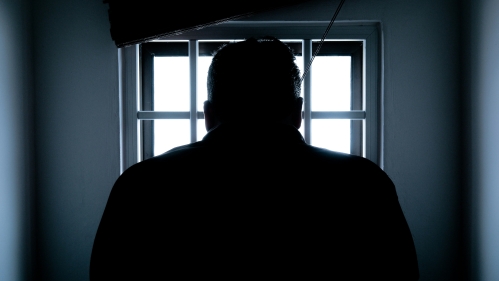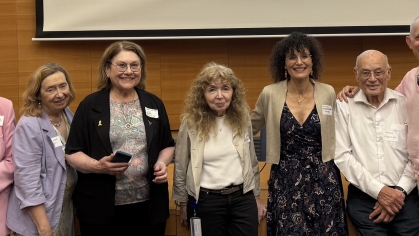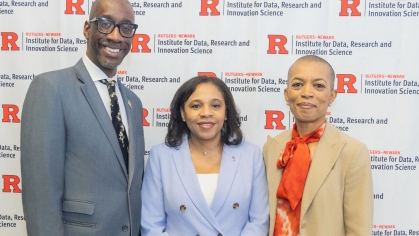Rutgers-Newark experts are working to raise awareness of the link between educational disability classifications and incarceration. They call it the “special ed to prison pipeline.’’
While many are aware of the school to prison pipeline–where majority youth of color are funneled away from public education and into the juvenile justice system—they don’t always recognize that disability and special education play a significant part, says Lauren Shallish of Rutgers-Newark’s Department of Urban Education and founder of the first Disability Studies program at the university.
In close partnership with Rutgers’ NJ-STEP program, which helps incarcerated students obtain degrees, she and her colleagues are working to change that.
According to Shallish, at least one in every three youth arrested in the U.S. has a disability.
“An overwhelming majority of the prison population identifies as disabled or becomes impaired as a result of incarceration,’’ she said. “But there is less attention to the role disability plays because its under the guise of clinical judgment, which many believe to be right and true, but can in fact be very subjective.”
While incarcerated people who consider themselves legitimately disabled are denied services both inside and outside prison, others were erroneously classified during their K-12 years, a designation that is disproportionately applied to Black and brown children. The label can hinder them academically and steer them toward interactions with the juvenile justice system, which often leads to adult prison, Shallish said.
“It moves students away from their peer groups and promotes an overall negative experience that students internalize as their own biological or character deficit. It can create an irreparable sense of inferiority,’’ she said.
The disparity especially targets urban communities of color, where children classified as disabled are more likely to wind up in hyper-surveilled, under-resourced, and segregated learning environments, said Shallish.
Black children in New Jersey are 30 times more likely to be detained or incarcerated than their white peers, even as Black and white youth are charged with committing offenses at similar rates. Black children in the U.S. are nearly five times as likely to be confined as their white peers.
Many students who are classified as having a behavior disorder have experienced long-term exposure to trauma or lack of disability access. They are misclassified as having a complex impairment or placed in a more restrictive setting, which can stigmatize them and prevent them from succeeding academically, according to Shallish.
Lacking support for emotional issues and denied access to the same curriculum as their peers, they can demonstrate behaviors that eventually lead to increased surveillance and interactions with law enforcement and family removal systems, according to Shallish.
In these settings, both for students whose classification may be fitting and those for whom it is not, the emphasis is often on discipline and passivity. “There are a lot of well-intentioned therapies and behavior management systems used in schools that ultimately just teach students to be compliant and follow orders from adults,’’ said Shallish. “Compliance is not a valuable skill for learning or quality to emulate.”
Sammy Quiles, an NJ-STEP graduate who earned a degree in Criminal Justice at Rutgers-Newark this year, was classified as learning disabled in second grade, a label that he believes contributed to his decision to drop out of school in tenth grade.
“I remember it vividly. I was seen by the child study team and it was a classification that followed me my whole life. The early diagnosis was that I was emotionally disturbed and that I had some type of learning disability.” he said. “But in my opinion, it was all based on behavioral problems, I couldn't sit still in class, I had outbursts.”
He remembers classrooms where he was separated from peers, who were challenged by a far more rigorous curriculum. “When you talked to them, you realized what you were learning was dumbed down. It was nothing compared to those in mainstream classes and I realized that almost immediately,’’ said Quiles, who could read and write above grade level.
In junior high, he was able to take some mainstream courses with the help of teachers who advocated for him. But by then, Quiles was already disillusioned. Discipline problems led him to be assigned to an alternative school, where the atmosphere was prison-like, with metal detectors, overzealous security guards and punitive policies that meted out suspension for minor infractions, like too much time spent in school lavatories.
At age 17, he committed a robbery with friends that resulted in a victim’s death and received a 30-year prison sentence. Quiles, who was not directly responsible for the fatality, is adamant about accepting accountability for the crime. But he believes the treatment he received as a student in special education fueled some of his behavioral problems.
“You can see the correlation,” he said. “When you’re treated like that and all of the institutions that you encounter treat you as a criminal and someone who is abnormal or doesn’t belong, you can see how it contributed to me acting out.’’
When given the opportunity, many students like Quiles graduate from colleges and universities, dispproving the belief that they lack the skills and potential to learn at an advanced level, said Shallish. “My area of research is in disability studies and higher education, so naturally many of my students had to survive the criminal legal system, school discipline, and restrictive special ed placements in order to get here. And their achievements abound.”
NJ-STEP’s incarcerated students, including those who were classified as having disabilities, have higher grade point averages, retention and graduation rates than their traditionally admitted peers.
Since the program began in 2011, 57 have completed a BA degree in a New Jersey prison, and another 137 have completed a baccalaureate degree on a Rutgers campus. Some have gone on to complete advanced degrees and are emerging leaders across multiple industries, according to Christopher Agans, Executive Director of NJ-STEP.
Shallish views this as proof that the right kinds of interventions and educational settings can nurture potential that has been thwarted. For instance, many who arrive in prison as functionally illiterate go on to educate themselves and their peers or enter programs where they earn advanced degrees. “But what matters is that students not be tracked toward prison to realize their potential in K-12 schools. It’s also important that universities continue to support educators and families in ways that are race-conscious, linguistically equitable, and disability affirming.”
As a Rutgers-Newark student, Quiles has worked for RU-N’s Department of Urban Education as a research assistant, grant writer, and teaching assistant and now works for the city of Newark as a case manager in the Alternatives to Incarceration program.
Like Shallish, he believes that classified students should be in general education classrooms with their peers and instruction for all should be designed with them in mind,
Research shows that when students are included in general education settings that encourage their strengths and honor their identities, everyone benefits. “In K-12, achievement for all students goes up in fully inclusive settings,’’ she said. “In higher education the long-term benefits are even greater.”
Changes cost very little and mostly involve shifts in teaching techniques and other inexpensive alternatives that save tax dollars by helping to keep students out of prison and on a path to be self-supporting. It’s also important to represent disabled and formerly incarcerated scholars in the curriculum and hiring practices, said Shallish.
’Even if you don’t do it for the moral reasons, there are financial and lasting community benefits,’’ she said.
‘



